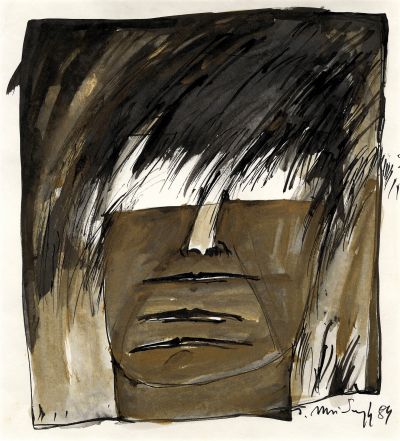Janina Musiałczyk. W drodze, on the road
Mediathek Sorted




































































































A piece of that other world
Musiałczyk’s decision to leave Poland brought themes surrounding departure, exodus, those left behind and passing landscapes to the fore of her artistic work, and continued to dominate it in the decades that followed. It proved advantageous that she had previously already worked in small formats on paper, and that now, in temporary, improvised accommodation, she could continue to produce series of drawings. She was only able to take a few of her own works with her on her journey. In Malmö, the “woven tapestry, a part of that other world”,[55] which had been purchased by the tenant of the apartment and which hung on the wall of one of the rooms.
During the year of her arrival in Hamburg, she produced a series, entitled “81”, of abandoned landscapes, windswept by storms, which look at the observers as faces (Fig. 74), stood opposite them in the form of female bodies or in which chasms appear.[56] They are related to the “seeing stones”, which she began to draw in her first apartment in Hamburg-Steilshoop, and which covered more and more walls two years later. The drawings show stones or large boulders with static faces, which look straight ahead or diagonally, lonely creatures related to the stones in an open, barren landscape, fallen into ravines, as female bodies grown out of the ground or locked in box-like rooms; a reflection of a state of mind that is frozen in grief and turned to stone.
Until 1990, she produced numerous further series of drawings entitled “Divided Landscape, Created Landscape” (Geteilte Landschaft, gestaltete Landschaft), “Here and There” (Hier und dort) and “People, Borders, Landscapes” (Menschen, Grenzen, Landschaften), in which different techniques are used, and landscape elements and human figures are symbiotically linked. While the titles refer to the migrant conflict of belonging to two different countries and cultures, in the image motifs, different stages of deep-rootedness in the landscape are portrayed on the one hand in contrast to ejection, displacement, and alienation on the other.
The figures are usually female, floating as angels with broken wings over the “divided landscape”, (Fig. 4) or with legs flowing with blood between “here and there” (Fig. 15) (both 1983). They turn into petrified formations in the landscape, buried deep in the earth below plough ruts, windswept trees, village landscapes and cemeteries (1984, Fig. 9, 12–14). Or, like the protagonist in Kafka’s novella The Burrow (Der Bau), they have hidden themselves in underground holes against the dangers of life, usually as sleeping “creatures from within the earth” [57] and rolled themselves up like an embryo (1986, Fig. 11). Being a woman is one of the central themes in Musiałczyk’s pictorial world.
Earth-coloured, frozen faces with gagged mouths and bound eyes are reminiscent of the gag on free speech during the dictatorship (1984, Fig. 2, 3) and are written for all time into the landscape with its ravines and trees (1984, Fig. 24). They fall from the sky as screaming comets (1985, Fig. 55), stumble through the room as “seeing stones”, (Fig. 7), form heavy rock formations with their bodies and hide, bent over, in the rocky sediment (all 1986, Fig. 10, 16). Finally, hidden in deep ravines, they are themselves threatened by a falling rock (1987, Fig. 73).
[55] Zeichnungen und Texte 2001 (see note 1), page 22.
[56] Other examples of the series mentioned here can be found on the artist’s website: https://www.janinainkamusialczyk.de (last accessed on 25/10/2023), under “Zeichnungen” (“Drawings”).
[57] Franz Kafka: The Burrow (Der Bau) (1923), in: Franz Kafka: The Burrow London 2017, page 184.





















































































